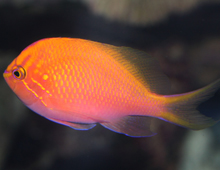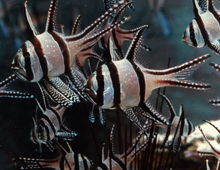Indonesia

Bellus lyretail angelfish, Genicanthus bellus
In most of the swallowtail angelfish species, the male has a more complicated pattern than the female. This species, found from the Philippines to remote islands of the South Pacific, is an exception. The male has a pattern of gold strips bordering a broad pinkish band. The female has a striking pattern of black, white, and purplish-blue. The Latin word “bellus” means “beautiful”. The Greek word “genicanthus” means “cheek spine”.
LEARN MORE
Flamboyant cuttlefish, Metasepia pfefferi
The Flamboyant cuttlefish is aptly named for its flashy coloration, which can change in an instant. It is a small species found in sand or mud substrates in tropical waters from Indonesia, through Papua New Guinea to Australia. Its coloration may be a signal to potential predators as this deadly beauty is the only cuttlefish species known to be toxic. It has recently been bred in controlled aquarium environments and has long been a coveted aquarium species. The Flamboyant cuttlefish feeds on small shrimp and other invertebrates, and has specialized tentacles that shoot out and capture their unsuspecting prey. When threatened, the Flamboyant cuttlefish can produce an ink screen to avoid predation.
LEARN MORE
Chocolate surgeonfish, Acanthurus pyroferus
The Chocolate surgeonfish is also known as the Mimic tang because as a juvenile it is yellow or cream colored and is thought to mimic several species of pygmy angelfish. As it matures, the yellow coloration changes to become more chocolate brown. The mimicry is thought to be a protective strategy that allows the tang to feed without being attacked by damselfish competing for the same food sources. Like other species of surgeonfish, the Chocolate surgeonfish bears a sharp spine on either side of the base of its tail.
LEARN MORE
Orange skunk clownfish, Amphiprion sandaracinos
The Orange skunk clownfish is found from the Eastern Indian Ocean and Western Australia to the Philippines and Melanesia. It is a close relative of the Pink skunk clown, A. perideraion, but differs in its orange coloration and single stripe along its dorsal area. Pink skunk clownfish, like their relatives are very territorial, rarely straying from the protection of their host sea anemone. They breed readily in aquariums and will spawn about every ten days. The average nest size is 300 eggs.
LEARN MORE
Fathead anthias, Serranocirrhitus latus
The Fathead anthias is also known as the Sunburst anthias because of the splash of yellow color on its face. It was originally described in 1949 and was placed in the hawkfish family. Its genus means grouper-hawkfish. These hardy aquarium fish generally prefer the protection of an overhang, or cave and can often be seen swimming upside down. Unlike their other anthias cousins, they have a deep body and elongate pectoral fins.
LEARN MORE
Black ocellaris clownfish, Amphiprion ocellaris
The Black ocellaris clownfish, or Black Percula clownfish as they are often called, are a color variant of the more popular Orange ocellaris, which is frequently confused with a true percula clownfish A. percula. They are generally small in size and can be found in small groups usually associated with a host sea anemone. The Black ocellaris clownfish is a hardy aquarium species and when kept in pairs can breed readily. Juveniles of this color variety can be light brown in color until they mature.
LEARN MORE
Banggai cardinalfish, Pterapogon kauderni
Bangaii cardinalfish are small striped fish that can easily camouflage themselves in the spines of sea urchin. Like other members of the cardinalfish family, male Banggai cardinalfish are mouth brooders. Once the eggs hatch, the male incubates the young fry in his mouth for up to one month. Because of this breeding behavior, Banggai cardinalfish have become very popular in the aquarium hobby.
LEARN MORE

